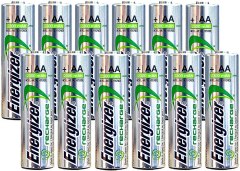BestReviews is reader-supported and may earn an affiliate commission. Details

The ability to hold a charge for up to a year in storage makes these great for backup power.
The ability to hold a charge for up to a year in storage makes these great for backup power.
Like similar top-quality batteries, these come factory-charged and also offer good reliability. Batteries hold a charge for a long time, even when they're not in use.
Rare users question if the batteries were old stock, as they didn't last long once charged.

These batteries wowed users and held up in performance to non-rechargeable lithium-ion batteries, despite their lower price.
These batteries wowed users and held up in performance to non-rechargeable lithium-ion batteries, despite their lower price.
Offering a lower cost than competitors, these batteries are noted for maintaining their charge.
A few customers noted they didn't last or recharge well, but this seemed like an atypical experience.

Popular rechargeable batteries by a top brand that come complete with a charger for added convenience.
Popular rechargeable batteries by a top brand that come complete with a charger for added convenience.
These batteries earn high marks for their durability and versatility. Available with a battery charger.
A few users report the batteries need frequent recharging.

If you need a set of rechargeable batteries that will power your most relied-upon electronics for a long time to come, this is your best bet.
If you need a set of rechargeable batteries that will power your most relied-upon electronics for a long time to come, this is your best bet.
Long-lasting batteries. Retain up to 85% of their charge after a year in storage. Rechargeable up to 500 times. Temperature-resistant. Made in Japan. Pre-charged.
A set of four rechargeable Eneloop batteries is fairly pricey.

Rayovac's batteries-and-charger combo pack is an excellent option for giving rechargeable batteries a try.
Rayovac's batteries-and-charger combo pack is an excellent option for giving rechargeable batteries a try.
Comprehensive bundle that includes two AA and two AAA batteries with a charger. Rated to charge batteries for up to 1,500 times. Built-in protection from overcharging.
Some batteries that wouldn't hold a charge and chargers that wouldn't charge slipped through quality control.

We recommend these products based on an intensive research process that's designed to cut through the noise and find the top products in this space. Guided by experts, we spend hours looking into the factors that matter, to bring you these selections.

It’s hard to argue with the convenience of battery-operated household appliances. With no annoying cord to bog you down, you can easily carry your battery-run items – hand vacuum, cordless drill – wherever you need to go without any worries about finding an outlet for the plug.
Unfortunately, traditional batteries require frequent replacements, which can get rather pricey. They’re not great for the environment, either. Thankfully, you can now use rechargeable batteries to power many of your favorite devices. Rechargeable batteries don’t require replacement. As the name suggests, you have only to recharge them when you run out of juice. After a short while, the batteries are ready to go again.
If you’re ready to buy some rechargeable batteries, we invite you to check out our recommendations. For general tips on shopping for rechargeable batteries, see our comprehensive guide.

Perhaps you haven’t made “the switch” from traditional alkaline batteries to rechargeables yet. Here are a few reasons why you might want to make the change.
Rechargeable batteries are economical. While it’s true that rechargeable batteries cost more upfront, you save money in the long run. Why? Because you can use them hundreds, if not thousands, of times. You’ll quickly earn back your investment when you buy rechargeable batteries.
Rechargeable batteries are convenient. You don’t have to run out and buy new batteries every time your alkalines burn out. And with a little forethought, you can arrange it so that you always have a set charged and ready to go.
Rechargeable batteries are environmentally friendly. They are an eco-friendly alternative that you can feel good about using because they don’t contain environmentally hazardous chemicals or metals. And because they can be used repeatedly, rechargeable batteries require fewer natural resources to produce than single-use batteries.

When you shop for rechargeable batteries, you’ll find that there isn’t just one “type.” Below, we delve into four of the main types of rechargeable batteries from which to choose.
NiMH rechargeable batteries are a high-performing option that is easy to find at most stores.
Pros:
Work well in high-drain items
Larger capacity than other types of rechargeable batteries
Can be reused 150 to 500+ times
Cons:
Don’t work as well in devices that require more than four batteries
May self-discharge if left unused for more than a month
An effective alternative to NiMH batteries, NiZn rechargeable batteries are another high-performing option.
Pros:
Work well in high-drain items
Provide higher voltage that can make flashlights brighter
Can last longer in some items than NiMH batteries
Cons:
Can discharge more quickly than other options due to high voltage
Can self-discharge if left unused for more than a month
Tend to lose charge quickly if used often
Must be used with a specialized charger
Only available in AA and AAA sizes
Can be hard to find at stores
Li-Ion batteries are a high-voltage rechargeable option. These batteries work well with some specialty items, such as flashlights.
Pros:
Suitable for high-drain devices
Cons:
Unavailable in standard voltages
May destroy devices that call for low-voltage batteries
Aren’t available in standard sizes, including AAA, AA, C, and D
Must be used with a specialized charger
NiCad batteries were the first rechargeable batteries to hit the market, but they are a poorly performing option these days. They also contain a toxic metal, cadmium, which is a concern for many people.
Pros:
Work well in high-drain items
Cons:
Lowest capacity among rechargeable batteries
Contain toxic substance, so must be disposed of at special recycling centers
Don’t work as well in devices that require more than four batteries
Can self-discharge if left unused for more than a month

Rechargeable batteries are available in a variety of sizes to accommodate most devices and appliances, including the following.
AA
C
D
9V
You can use rechargeable batteries just as you would single-use styles, so choose the sizes that your devices call for.
The amount of energy a rechargeable battery can store is measured in milli-ampere hours, or mAh. The higher the battery rating, the longer the battery will last per charge. An 1800mAh battery will last three times as long as a 600mAh battery, for example. However, batteries with lower mAh ratings take less time to recharge.
The mAH ratings for rechargeable batteries varies. We offer the following general guidelines.
Choose AAA batteries with capacities between at least 600 and 1300mAh.
Choose AA batteries with capacities between at least 1200 and 2700mAh.
Choose C batteries with capacities between at least 2500 and 6000mAh.
Choose D batteries with capacities between at least 5000 and 8000mAh.
Some rechargeable batteries are sold as sets that include a charger. Others are sold separately, so you must purchase the charger on your own.
NiZn and Li-Ion batteries require specialized chargers, but NiMH and NiCd batteries can be used with universal chargers.
Some chargers require you to charge the batteries in groups of two, four, six, or eight. This may be inconvenient if you only need a single battery for a smaller device, so consider a charger that allows you to recharge the batteries one at a time.
When choosing a charger, be sure it has a button that allows you to easily run a discharge cycle. A discharge cycle occurs when the battery is fully drained and then charged to full power again. It should be done every few months to prevent the batteries from losing their full charge capacity.
Rechargeable batteries are available in packages that range in quantity from four to 24. While most packages contain a single battery size, some rechargeable batteries are sold in packs that contain a variety of sizes. For example, you might purchase a package of rechargeable batteries that includes both AAAs and AAs.

Rechargeable batteries vary in price based on their size, type, and how many are included in a pack, but you can typically expect to spend between $6 and $60. The following guidelines offer a general idea of what to expect in terms of price.
For a four-pack of rechargeable batteries, you’ll usually pay between $6 and $24.
For an eight-pack of rechargeable batteries, you’ll usually pay between $10 and $45.
For a 16-pack of rechargeable batteries, you’ll usually pay between $14 and $50.
Use your rechargeable batteries regularly. They can develop crystals that prevent them from charging properly if they aren’t discharged and recharged consistently.
If you don’t use your batteries regularly, allow them to discharge power completely at least once every few months – then recharge them. This will help prevent crystals from forming.
Use a normal charger to recharge your batteries. Ultra-fast chargers often don’t charge the batteries fully and may cause damage.
Always recharge your batteries at room temperature. Avoid extremely low or high temperatures to protect the batteries.
Don’t charge batteries that feel hot to the touch. Allow them to cool completely before attempting to recharge them.
You don’t have to wait until rechargeable batteries are drained of all their power to recharge them. In fact, waiting until they’re fully discharged can sometimes cause damage.
Store your rechargeable batteries in a cool location. Make sure they’re at least partially charged before you put them away.

Q. Do rechargeable batteries work with all types of devices and appliances?
A. Rechargeable batteries can work with a variety of devices, but they’re not the best option for low-draw items such as clocks, TV remotes, and smoke alarms. Because the batteries automatically discharge a small amount each day, they typically last only about three months in a low-draw device before needing a recharge.
Q. How long do rechargeable batteries last?
A. The lifespan of the batteries is measured in charge cycles, which consist of each time the battery is fully discharged and then fully recharged. As a result, the more often you use the batteries, the shorter the battery lifespan will be.
Most rechargeable batteries last 500 to 800 charge cycles. Depending on how often you use the item, this could add up to one or two years.
Q. How do you dispose of rechargeable batteries?
A. Many rechargeable batteries contain toxic substances, so they must be recycled rather than thrown out with the trash. Some stores run recycling programs that allow you to bring the batteries back to the store, and some manufacturers sponsor mail-in programs that allow you to mail the batteries back for recycling.
Get emails you’ll love.
Learn about the products you’re wondering if you should buy and get advice on using your latest purchases.
